


|
|
|
 hile
cutting is a wonderful thing, all cutting tools wear as you use them.
The wood itself, particularly tough
fibers and mineral
extractives,
erode and abrade the metal, dulling the edges. If you use cutting tools,
sooner or later you will have to sharpen them. hile
cutting is a wonderful thing, all cutting tools wear as you use them.
The wood itself, particularly tough
fibers and mineral
extractives,
erode and abrade the metal, dulling the edges. If you use cutting tools,
sooner or later you will have to sharpen them.
To sharpen a dull tool, you
must do three things:
 |
Hone a keen edge with progressively finer
abrasives.
|
 |
Restore the edge to the proper tool angle.
|
 |
Grind it to the proper shape. |
|
|
HONE A KEEN Edge
|
|
To create a crisp, keen
cutting edge, finish the metal surfaces with progressively finer
abrasives, making them as smooth as possible. If you use only coarse
materials to sharpen, the edge will be rough.
When you sharpen, the abrasives cut small
grooves in the surface of the metal -- both the leading face and the
trailing face. These grooves intersect at the cutting edge. On a
microscopic level, they appear to form tiny teeth. The finer the grit of
the abrasive, the smaller the teeth, the the closer the cutting edge
comes to forming a single, crisp line -- a perfectly keen
edge.
Why not sharpen with just one fine grit?
Because it's difficult to remove damaged areas and restore badly |
worn edges with fine grit. You also run the
risk of overheating the tool if you use power sharpeners -- fine grits
produce heat faster than coarse grits. Coarser grit removes metal faster
and keeps the tool cool. It's faster and safer to work your way up
through a series of progressively finer grits.
How fine should you sharpen?
That depends on the tool and your personal preferences. For most
applications, itís sufficient to grind and hone to between 500 and 700
(U.S.) grit. But many craftsmen polish and strop to 1,200 grit and
beyond for the keenest possible edge.
There are four sharpening levels, roughly defined by the abrasive grits used.
As you sharpen with finer and finer grits, the cutting edge grows
keener. NOTE: The grits are graded according to the U.S. system.
|
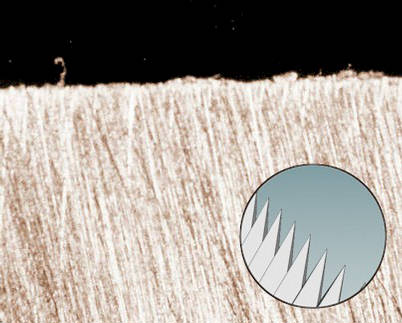
GRINDING
(60
Ė 300
GRIT) |
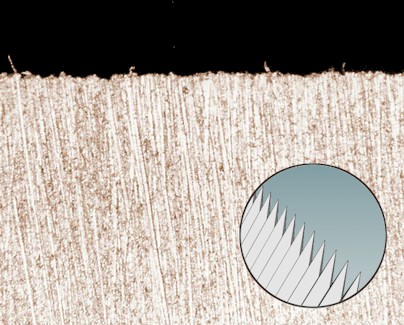
HONING (300
Ė 700
GRIT) |
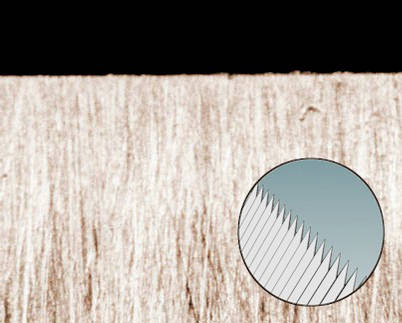
POLISHING (700
Ė 1,200
GRIT) |
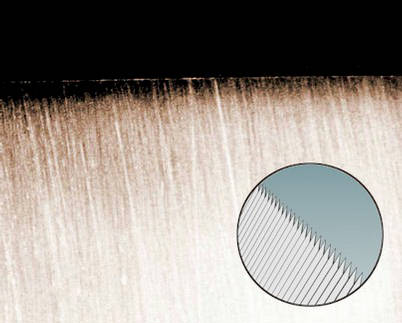
STROPPING (ABOVE
1,200
GRIT) |
RESTORE THE TOOL ANGLE
|
|
To maintain the correct tool
angle as you work your way through finer abrasives, use a sharpening guide
or a tool holder. This eliminates the natural tendency to rock the
chisel as you sharpen it, thereby
rounding the face. You can get away without guides when youíre just
touching up a tool ó polishing a slightly-worn edgeó because you donít
remove much metal. But even experienced sharpeners admit they can
maintain the tool angle more precisely with a guide.
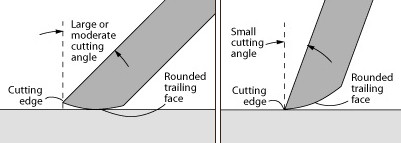
If you inadvertently round the trailing
face (giving it a cannel grind) when you sharpen a tool, the cutting edge will not meet the wood
unless you decrease the cutting angle.
|
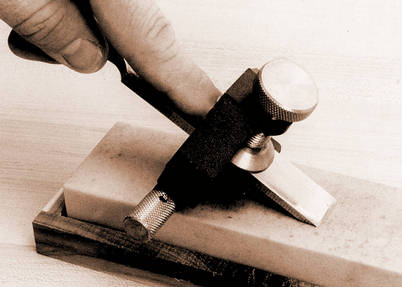
The sharpening guide shown --
from Veritas -- is designed for hand sharpening straightedge chisels and
plane irons. There are many types of guides not only for different
tools, but also for hand sharpening and machine sharpening. The purpose of all of them is to
maintain a constant angle as the
tool is sharpened.
|
GRIND THE PROPER SHAPE
|
|
|
Most woodworking tools are ground flat
by the manufacturers. Thereís rarely any reason to change to a cannel
grind, but a hollow grind offers an advantage in some applications.
On a hollow grind, the actual tool angle
(at the point) is 2 to 5 degrees less than the apparent tool angle (at
the heel), depending on the radius of the abrasive wheel and the length
of the hollow face. This reduces the force needed to drive the tool.
However, there is a trade-off ó a hollow-ground tool has less metal to
buttress the cutting edge and it wears faster. For this reason,
hollow-grind only light-duty tools such as carving knives and paring
chisels. Others are best flat-ground.
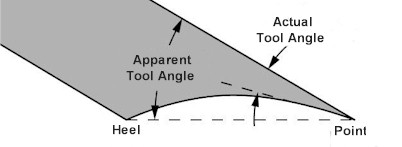
HOLLOW GROUND CUTTING EDGE
|
 |
Sharpen more, grind less --
Some craftsmen hollow-grind a face
before they flat-grind the cutting edge. This practice doesnít change
the force needed to drive the tool or the durability of the cutting
edge. Instead, it reduces the amount of metal that must be removed to
restore the edge and speeds the sharpening process.

METAL
REMOVED FROM ENTIRE FACE

METAL
REMOVED FROM POINT AND HEEL ONLY
|
MICROBEVELS
|
|
|
You may also wish to add a microbevel to
a cutting edge after sharpening it. A microbevel (also called a
secondary bevel) is a tiny bevel at the point that increases the tool
angle. It helps remove burrs and makes the edge more durable. (It does
not make the edge sharper; thatís a myth.) Because the microbevel is so
small, the force required to make the cut increases only slightly.
To make a microbevel, sharpen the tool
as you would normally. Then increase the tool angle a few degrees and
make 2 or 3 passes ó no more ó over the finest abrasive. If the normal
tool angle is 15 to 20 degrees, make the microbevel 5 to 7 degrees
steeper. If itís more than 20 degrees, make it 3 to 5 degrees steeper.
Tool angles of 30 degrees or more rarely need a microbevel; they are
plenty durable without one.
|
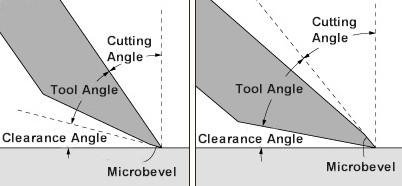
In most cases itís
best to make a microbevel on the trailing face of a tool so it decreases
the clearance angle. This is because the clearance angle is usually less
critical than the cutting angle. However, if the clearance angle is
extremely small, you will be better off making the microbevel on the
leading face.
|
|

Back to the top
|
|
   |